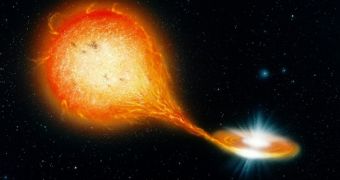A new paper accepted for publication in the Monthly Notices of the Royal Astronomical Society Letters announces the discovery of a hybrid star known to the scientific community as a Thorne-Żytkow object.
In said paper, researchers detail that what makes such hybrid stars fairly unique – apart from the fact that just one has been detected until now, that is – is their peculiar anatomy.
Thus, Thorne-Żytkow objects are believed to come into being when a red supergiant star and a neutron star get together, share a glass of wine, cuddle, and decide that they never again want to be parted from one another.
In scientific terms, the massive red supergiant star gobbles up the neutron star, which eventually finds itself spiraling into its lover's core.
The hybrid star described by Emily Levesque of the University of Colorado Boulder and fellow researchers is dubbed HV 2112, and it sits in the Small Magellanic Cloud.
By the looks of it, the University of Colorado Boulder scientist and colleagues have concluded that it must be a Thorne-Żytkow object after identifying rubidium, lithium and molybdenum in excess in its makeup.
Thus, the fact that HV 2112 packs significant amounts of these three compounds is considered an indicator of the fact that it is a hybrid between a red supergiant superstar and a neutron star.
Interestingly enough, Thorne-Żytkow objects were first proposed as a theoretical class of stars by physicist Kip Thorne and astronomer Anna Żytkow back in 1975. If HV 2112 is indeed a hybrid, the class will no longer be just a theoretical one.
“We could, of course, be wrong. There are some minor inconsistencies between some of the details of what we found and what theory predicts,” study co-author Philip Massey with the Lowell Observatory in Flagstaff, Arizona, wishes to stress.
“But the theoretical predictions are quite old, and there have been a lot of improvements in the theory since then. Hopefully our discovery will spur additional work on the theoretical side now,” he adds.

 14 DAY TRIAL //
14 DAY TRIAL //